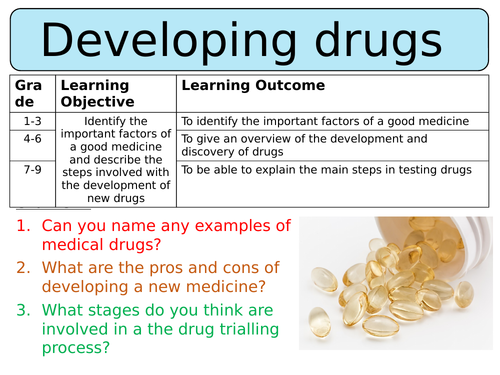
This is a resource for the NEW AQA GCSE Biology 'Infection & Response' unit.
Please find further resources designed to meet specification points for the NEW AQA Biology, Chemistry and Physics specifications at: https://www.tes.com/teaching-resources/shop/SWiftScience
Pupils will firstly consider some traditional medicines such as digitalis for dropsy, willow trees for aspirin and penicillin mould.
Pupils then consider the time and money taken to conduct a drug trial, as well as the stages that are involved. Pupils will watch a video to determine the definition of a placebo and a double-blind trial, pupils should also use the video to identify how clinical scientists maintain a fair test during a clinical trial.
The next part of the lesson pupils will be introduced to what happens during the pre-clinical trial phase and the three stages of the clinical trial phase. Once students have learnt this they will need to match the key words to the definitions. They will also be given a set of 6 statements which they need to write in order, as a flow diagram, in their books to represent the stages of the drug trialling process. Pupils can then self-assess their work.
There is a 6-mark question on what they have learnt this lesson. To really test pupils' knowledge they should try and complete this in the back of their books, perhaps giving them a set of key words as prompts. For a less able class, they should be able to use their notes from the lesson. Pupils can peer-assess their work using the marking criteria on the PowerPoint slide.
All of the resources can be found on the PowerPoint slide, there is also extra resources at the end which could be used in an extra lesson or as a homework activity.
Other lessons from the 'Infection and Response' unit can be found in my TES shop :)
Please find further resources designed to meet specification points for the NEW AQA Biology, Chemistry and Physics specifications at: https://www.tes.com/teaching-resources/shop/SWiftScience
Pupils will firstly consider some traditional medicines such as digitalis for dropsy, willow trees for aspirin and penicillin mould.
Pupils then consider the time and money taken to conduct a drug trial, as well as the stages that are involved. Pupils will watch a video to determine the definition of a placebo and a double-blind trial, pupils should also use the video to identify how clinical scientists maintain a fair test during a clinical trial.
The next part of the lesson pupils will be introduced to what happens during the pre-clinical trial phase and the three stages of the clinical trial phase. Once students have learnt this they will need to match the key words to the definitions. They will also be given a set of 6 statements which they need to write in order, as a flow diagram, in their books to represent the stages of the drug trialling process. Pupils can then self-assess their work.
There is a 6-mark question on what they have learnt this lesson. To really test pupils' knowledge they should try and complete this in the back of their books, perhaps giving them a set of key words as prompts. For a less able class, they should be able to use their notes from the lesson. Pupils can peer-assess their work using the marking criteria on the PowerPoint slide.
All of the resources can be found on the PowerPoint slide, there is also extra resources at the end which could be used in an extra lesson or as a homework activity.
Other lessons from the 'Infection and Response' unit can be found in my TES shop :)
Get this resource as part of a bundle and save up to 45%
A bundle is a package of resources grouped together to teach a particular topic, or a series of lessons, in one place.
Something went wrong, please try again later.
Report this resourceto let us know if it violates our terms and conditions.
Our customer service team will review your report and will be in touch.
£3.00
